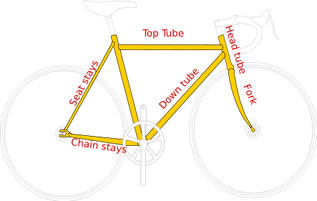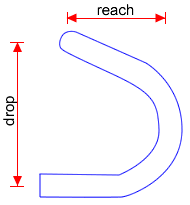Note that although this guide is oriented toward road bikes, the same principles apply when shopping for a women-specific mountain bike.
Buying a bike? Great! That's a wonderful, positive step for you - we hope you'll enjoy the shopping experience and find a bike that you love - and more importantly, one that loves you back.
When you walk onto a bike showroom floor, the vast majority of bikes you'll see are designed around the proportions of the average man. Women are built differently. On average, we have shorter torsos, shorter arms, and longer legs than a man of the same height. Our hands and feet are smaller, and our shoulders are narrower. And - no surprises here - our hips are wider. All of these differences can affect the way a bike fits, feels, and handles.
We have contact with the bike in three regions - our hands control the steering, braking, and shifting of our bike through the handlebars and the controls that are attached to them, our feet are in contact with the pedals, and our rear end is in contact with the saddle. And we've already established that women have significantly different proportions in all three areas, as well as in the spaces in between them!
A bike that's designed from the ground up to fit a woman, rather than a man, will provide fit and features in these three contact areas that optimize the fit for the average woman. Note that I'm still saying "average" here! We're all different - what works great for you may not be best for another woman. But a "Women's Specific" (also known as "WSD™" or Women's Specific Design on Trek bikes) gives many women a better chance of a comfortable fit with fewer modifications.
SO...WHAT MAKES A BIKE WOMEN'S SPECIFIC?
Different bike manufacturers, understandably, have different approaches to designing a Women's Specific bicycle. Some modify a stock "unisex" frame by changing to a shorter stem, smaller handlebars, shorter cranks, and a wider saddle. Others take a more comprehensive approach, actually designing their Women's Specific frames differently - often with a shorter top tube, a more relaxed head tube angle, a taller head tube, and perhaps a slightly steeper seat tube angle.
Shortening the top tube decreases the reach between the saddle and the handlebars - the most common problem for female cyclists due to our shorter torsos. Just shortening the top tube, though, can lead to other problems - less stable handling and increased toe overlap - unless other modifications are made.
Relaxing the head tube angle slightly moves the front wheel further forward, so that toe overlap is less likely. A relaxed head tube angle also lengthens the wheelbase slightly, which makes for more stable steering. A taller head tube and steeper seat angle make it easier to accomplish a shorter top tube - minimizing toe overlap and at the same time increasing comfort by reducing neck and upper body strain (taller head tube), and taking advantage of a woman's longer femurs (steeper seat angle).
Besides frame geometry, many other modifications can be made to a bicycle to make it more user-friendly for a woman:
- the handlebars can be smaller (narrower, shallower drop, and shorter reach) and the stem can be shorter and/or more upright, to further reduce the reach to the bars.
- the brakes and shifters can be sized for smaller hands
- the saddle can be wider in the rear to accommodate a woman's wider sit bones ("ischial tuberosities, if you want to be fancy!") and perhaps have a cutout to prevent soft tissue damage.
- the weight and stiffness of the materials used can be altered to better suit a lighter-weight rider
- smaller wheels and tires (such as 650C) can be used to prevent toe-wheel overlap
- and of course the bike can be painted in a different color scheme!
AND...WHAT ABOUT CUSTOM?
If you've got time, money, and patience to invest in the process, you might ask yourself, "Why settle for Women's Specific, when I can have ME Specific?" And - you're right. A bike that's designed to fit YOU can fit you, and your riding style, better than an off-the shelf womens' bike.
A good custom framebuilder will spend considerable time and effort to make sure that you get exactly what you want/need. This may end up being a fair bit different from what you THINK you want when you start the process - years of experience on the framebuilder's part will guide the process along with your input.
The first step toward a good custom build is a solid bike fit. A qualified professional will measure you, take into account your riding style, your flexibility, and your joint angles, and make recommendations for sizing a bike. Your frame builder will take all of this information into account, along with your preferences, when building your frame.
A custom builder can use size, weight, and purpose-specific materials to give your bike the "feel" that you want. Want to ride a fully loaded cross-country tour? You may end up with a stiffer frame than if you want to ride fast centuries comfortably.
Some manufacturers, such as Seven Cycles, have custom programs that complement their stock bike offerings.
Most custom bikes are made out of steel, though custom bikes may be found from any material imaginable.
Although any custom framebuilder can make a great womens' bike, Sweet Pea Bicycles
makes some of the sweetest steel bikes on the planet, right here in Portland, Oregon!
GLOSSARY:

Top tube
horizontal or slightly sloping tube that runs from the saddle to the front of the bike.
Head tube
tube on the front of the bike frame that connects the fork to the handlbears.
Seat tube
tube connecting the crank/bottom bracket to the pedals.
Downtube
tube connecting the head tube to the cranks.
Seat stays
tubes connecting the saddle/seatpost/top of seat tube to the rear wheel.
Chainstays
tubes connecting the crank/bottom bracket to the rear wheel.
Front fork
connects the front wheel to the head tube/handlebars.
Bottom bracket shell
holds the all-important bottom bracket - which connects the frame to the cranks.

Drop
distance between the top and bottom of the bars. A smaller hand would appreciate a smaller drop.
Width
distance from one side to the other. Usually measured from "center-to-center" of the bar. Typically stock road bikes have a 40 cm bar width, but many women may prefer a 38 or 36-cm bar. If the bar is much wider than your shoulders, you'll have to brace yourself to keep your upper body stable on the bike, and most people don't find this comfortable.
Reach
horizontal distance from the stem to the very front of the bars (how far the bar sticks out from the bicycle). With a short reach, the levers are closer to you.
MATERIALS
Steel
easiest to work with, wide range of characteristics that are fairly easily modified. Modern steel bikes can be made almost as light as any other frame material. A finely-crafted steel bike has a ride quality that other frame materials aspire to.
Aluminum
one of the lightest materials, but often judged to be a harsh ride - especially for smaller riders. To compensate for this, tubes made of aluminum are often oversized. This allow for a thinner-walled tube, with a nicer ride quality, while maintaining strength. Can be more difficult to weld than steel.
Titanium
formerly thought of as an exotic material, titanium is lighter than steel, and has a slightly better strength/mass ratio. Also has a slightly softer road feel than steel, which makes it a great choice for a bike you're planning on riding long distances. Much more difficult to weld than steel. Not subject to corrosion, so a titanium frame can be a lifetime investment.
Carbon
all bikes we think of as being "carbon fiber" are really carbon fiber impregnated resin. That is to say, plastic. Carbon fiber is an extremely lightweight material, and has superior vibration damping and stiffness, which makes it possible to have a very comfortable bike that is also very efficient at power transfer. Because of the cost involved in making molds, most carbon fiber bikes are stock, not custom.
Toe-Wheel Overlap
potential contact between the rider's foot and the front wheel during turning maneuvers, which is more likely on smaller frames. Typically this only happens at very slow speeds, because at higher speeds we never turn the front end very sharply. If there's too much toe overlap, the rider could stall out her front wheel and fall. Although many bikes have some possibility of toe overlap, it's a good idea to avoid too much.
WSD™
Women-Specific Design
Trek's term for their women's specific designs; intentionally designing a bicycle from the ground up to fit female proportions better.

